Twigs and Branches - May 2023
A web of present and past events
Kids Visits to the Garden Need Support
Help connect K-12 students with nature at the Eloise Butler Wildflower Garden.

Structured visits by school age children are back on the program at the Wildflower Garden this season with the Friends funding transportation costs.
On Garden field trips, naturalists with the Minneapolis Park and Recreation Board (MPRB) inspire kids with wonder and curiosity about the natural world and connect a new generation to this special place. Not all schools have funds for bus transportation to the Garden. That's why the Friends and MPRB are committed to ensuring the file trips are financially accessible.
You can help by donating to this program. MORE DETAILS AT THIS LINK
The Wildflower Garden in June
While the highlights of the Garden in May were in the woodland and wetland, the upland begins to offer bright hues to see in June and begins the transition to its July dominance in color over the lower garden.
- Look for the Canada Anemone in the Woodland Garden and of course, the Showy Lady’s-slipper in the wetland around June 10th to 20th.
- In the upland, the Indigos and the Golden Alexander will be in bloom along with the wild roses, the Foxglove Beardtongue, the Toadflax and the Canada Lily.
- Interested in summer programs at the Garden? - visit the Garden’s website for a listing.
- Here is a photo reference to an entire cast of early summer blooming plants - as they bloom at different times, each visit will present something different.
- Showy Lady's-slipper photo page.
Below: A grouping of Canada Anemone, (Anemone canadensis)
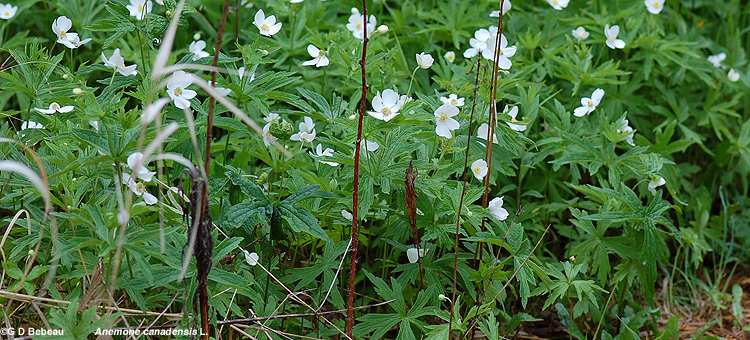
Lady's-slippers of the Garden
As we near the time of the Lady’s-slippers lets take a look at the current inmates of the Garden and those that once were.
Former Eloise Butler Gardener Cary George wrote: “The decline of the lady’s-slippers’ population in the Twin Cities is a sad tale. In the early part of the 1900s Pink Lady’s-slippers, Yellow Lady’s-slippers, and Showy Lady’s-slippers could be found in abundance in what is now the Minneapolis Chain of Lakes. Stories about young boys digging lady’s slippers in the tamarack bogs and selling them for 50 cents are numerous.”(1)
The Wildflower Garden is one of the sanctuaries where these species can be preserved. But natural habitat changes within the Garden over the last 100 years have lessened the ability to showcase those that once were grown here. The present species are the Yellow Lady’s-slipper (Cypripedium parviflorum var. pubescens) and the Showy Lady’s-slipper (Cypripedium reginae). The yellow typically begins bloom in late May, the Showy not until early June. Only the Showy is indigenous to the Garden.
In years past four others that are native to Minnesota were introduced but as they were not native to the habitat of the Garden; as the Cypripedium species is quite specific about habitat, long term success was not achieved.
Introduced in 1907 was the Stemless Pink Lady’s-slipper, still found in the nearby Quaking Bog. In 1911 came the smaller Yellow Lady’s-slipper followed in 1912 by the White Lady’s-slipper which will grow in moist prairies. Then in 1915 came the Rams head Lady’s-slipper.
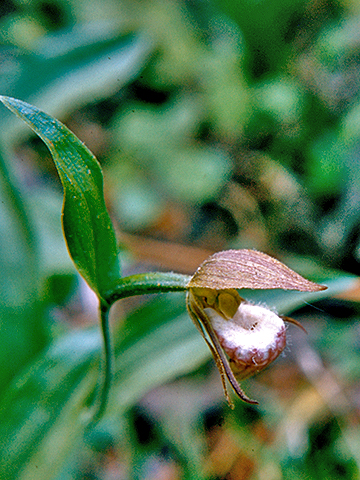

These species grew, but continuous replanting was required to maintain them - it is all about having the necessary soil and water conditions for each species. As an example - the Small White was replanted 18 times between introduction and 1956, The Yellow (larger) 21 times in that time period.

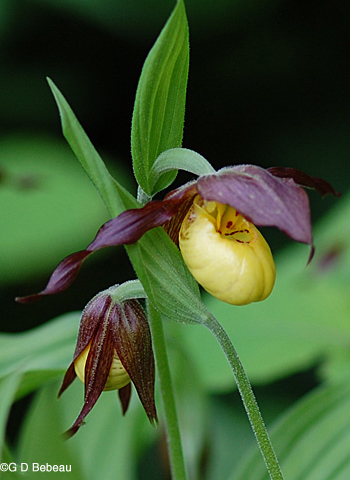
To have a complete list of species once present we must add three experimentals tried by Martha Crone. These three, all western inter-mountain species, were not successful at all.
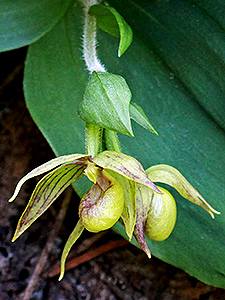
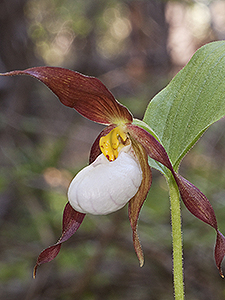

Below: The Showy Lady's-slipper, (Cypripedium reginae)

Eloise wrote this in 1926: “What changes have been wrought by the rapid growth of the city and the onward march of “improvements”! The shy woodland plants are fast dying out on our river banks; the tamarack swamps have been drained, and with the drying up of the water have disappeared the wondrous orchids and the strange insectivorous plants.”(2)
What has changed in the last 100 years? Are we not still draining potholes and wetlands, converting habitat to other use, paving over the lands, drawing down the water table, polluting wetlands and streams with runoff?
Here are links to more detail on the -
Showy Lady's-slipper,
The Stemless Pink Lady’s-slipper
the larger Yellow Lady's-slipper and the
smaller Yellow Lady's-slipper.
Notes:
*CC-BY and a number refers to a license to use these photos by Creative Commons. The number refers to the type of license. Use of Creative Commons photos is explained at this link.
(1) The Fringed Gentian™, spring 2000, Vol. 48 No. 2
(2) The Wild Botanic Garden - Early History by Eloise Butler, 1926
The indigos

In June the Indigos will bloom. There are three in the Wildflower Garden - all of the genus Baptisia of the pea family (Fabaceae).
These upright plants form large clumps of foliage with the sturdy flower stems rising vertically above the leaves which are three-parted.
The Garden inhabitants are the Plains Wild Indigo (Baptisia bracteata - ivory to yellowish flowers), the False Blue Indigo (Baptisia australis) and the False White Indigo (Baptisia alba var. macrophylla).
Why are two named “false?” It’s a poor choice of word but it was used to separate these two species from the “true indigo” (Indigofera tinctoria with pink to violet flowers) which produces the beautiful blue indigo dye. The “falsies” will produce dye, but it is very inferior. In all other respects they qualify to be classed in the Baptisia genus.
The two “false” indigos will be easily visible from the paths on visit to the upland at Eloise Butler but the Plains Indigo is off the path and not seen.
All the indigos have flowers true to the typical “pea” flower - that is - 5 petals where the larger upper banner petal turns upward and reflexes backward toward the calyx. There are two lateral petals projecting forward and two keel petals between them that house and hide the reproductive parts. Large bees can force open the petals to reach the pollen. All produce a woody seed pod that will remain on the upright stems over winter, providing some winter interest and food for any interested bird.
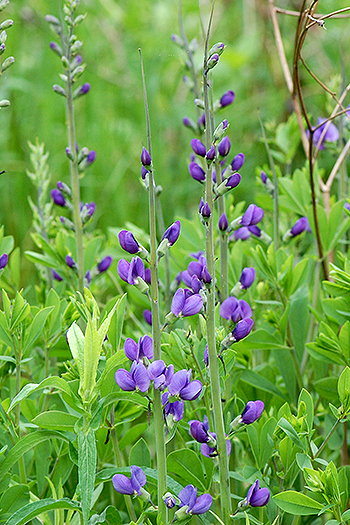

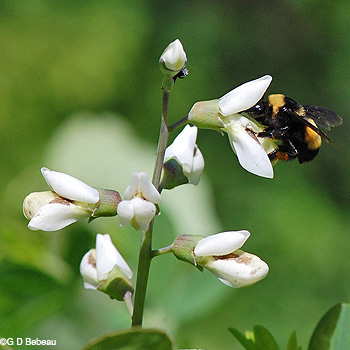
The original Wildflower Garden was marsh and wooded hillsides; these plants are upland prairie plants, so they are not native to the Garden. All were introduced by Eloise Butler. The Plains and the False White are native to Minnesota, but on the Minnesota DNR’s Special Concern List. The False Blue is native to the eastern part of the U.S. where it is endangered in several states. Thus the Wildflower Garden protects these important species.
Eloise Butler wrote in 1926 "And who could describe the outlying prairies, rioting in colors far exceeding the brilliancy of tropical flora... The land has been ruthlessly stripped of the exquisite features that Nature, the greatest landscape gardener, has wrought through the ages, and “all the king’s horses and all the king’s men” can never make the place the same again."
Deterioration has continued since Eloise Butler's day. Only in isolated remnants of that prairie and in sanctuaries such as Eloise Butler can these species now be found. If you have a home wildflower garden, try your hand with these. The False White and the Blue will grow in most sunny locations. Bare roots and plants are available from native plant nurseries.
Links to detailed information sheets:
False White Indigo
False Blue Indigo
What is green, fast growing, small but with a big future?
A new green-energy source

Let us now behold the lowly aquatic plant - Duckweed. It may no longer be the laughingstock of the pond world - a plant that appears so innumerable that some call it pond scum. It has been discovered how to produce quantities of oil from duckweed that can be converted into bio-diesel and into edible oils for food use.
Control grown duckweed can produce seven times more oil per acre than soybeans - our most commonly used oil plant for transportation and also for many food products.
The research has been done at Cold Spring Harbor Laboratory in New York and I invite you to read the release from the lab that is linked here.

Duckweed, mostly in the genus Lemna, is common on all continents save Antartica, and will grow in some polluted waters. One of the comments brought out in recent publications is this by the edible food plant grower Crop One: “Most plant-derived protein on the market today is seed based, including soy, beans, and nuts, which are often deficient in one or more key amino acids, preventing the use of a single plant to provide complete protein for human diets. In contrast, like broccoli or spinach, leaf-derived Lemna protein has a more complete profile with high levels of the essential amino acids methionine and lysine.” (Dec 19, 2022)
There are plants of the family Lemnaceae of which there are at least 11 in North America and 3 are common in Minnesota. See our article on Common Duckweed.
Below: A common scene in marshes and ponds - duckweed covering the surface.

Previous articles
All selections published in 2023